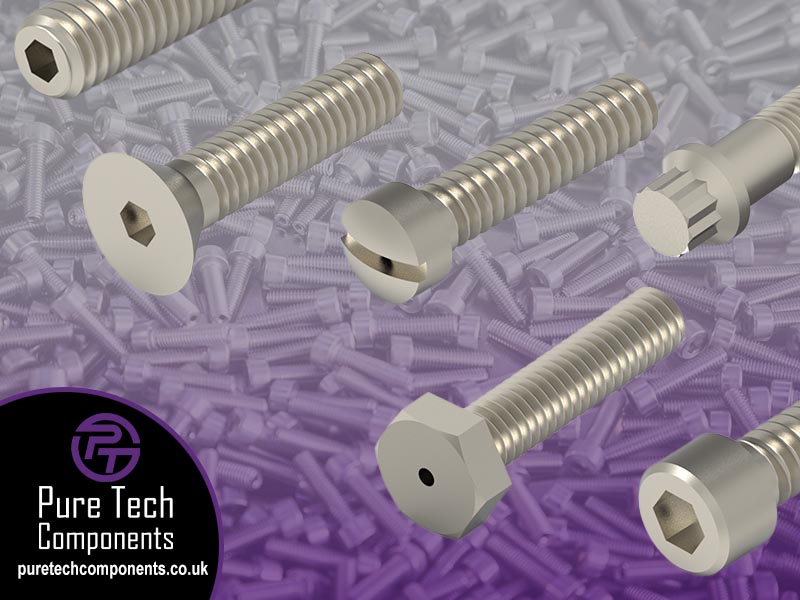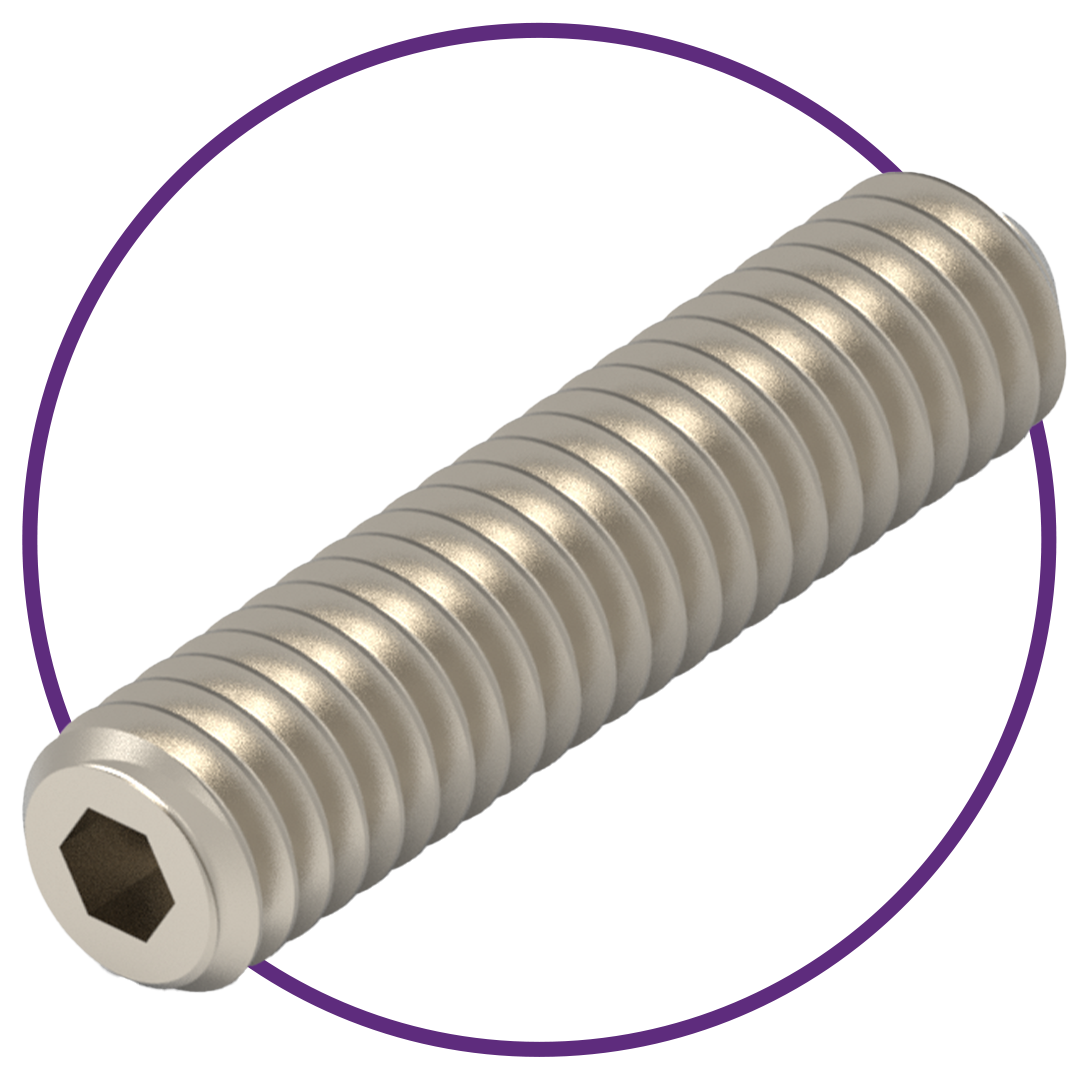
Did you know that the first known recorded use of screws occurred during the time of the ancient Greeks; they used them in devices to press olives and grapes. From those humble beginnings, screws have become one of the most widely used pieces of hardware manufactured today.
Fastener hardware comes in a wide variety of shapes, sizes, styles, and materials. One of the most important considerations when selecting a fastener for your application is what type of head the screw will have.
Here we give a brief overview of some of the most common screw head types along with their typical applications.
 |
SOCKET HEAD CAP Socket head cap screws are machine screws with a cylindrical barrel shaped head containing a hexagonal socket to fit a wrench for turning rather than a slot or external hexagonal. These properties mean that socket head cap screws are well suited for use within confined spaces. Socket cap heads are smaller; hence, the size of the component parts can be reduced, reducing material costs. Smaller parts cost less to drill and tap, take less energy to drive, and weigh less than alternatives. |
 |
BUTTON HEAD SOCKET CAP Button head socket cap screws have a rounded, low-profile head containing a hexagonal socket to fit a wrench for turning rather than a slot or external hexagonal. These properties mean that Button head socket cap screws are well suited for use within confined spaces. Due to their flush profile, these types of screws are ideal for areas with very little overhead or clearance. They are best used in light-duty applications, such as removable panels, however, their wider bearing surface and high tensile strength make them a reliable choice for some security applications as well. |
 |
SOCKET SET SCREW Socket set screws are a type of screw generally used to secure an object within or against another object. The most common examples are securing a pulley or gear to a shaft. Socket set screws are headless, meaning that the screw is fully threaded and has no head projecting past the major diameter of the screw thread. A socket set screw contains a hexagonal socket to fit a wrench for turning rather than a slot or external hexagonal. Fastening for these components requires no external clearance. These properties mean that socket set screws are well suited for use within confined spaces. The socket set screw passes through a threaded hole in the outer object and is tightened against the inner object to prevent it from moving relative to the outer object. It exerts compressional or clamping force through the bottom tip that projects through the hole. |
 |
FLAT HEAD SOCKET CAP Flat head socket cap features a low-profile and countersunk head. They are ideal for applications requiring a strong fastener with a flush mount. They are often used in projects that require moving parts to pass over a fastened area. Because of their ability to mount flush with the surface, they are less apt to snag objects moving overhead. Flat-head socket cap screws are produced with a socket drive that contains a hexagonal socket to fit a wrench for turning. |
 |
FLAT HEAD PHILLIPS Flat head Phillips screws feature a low-profile and countersunk head. They are ideal for applications requiring a strong fastener with a flush mount. They are often used in projects that require moving parts to pass over a fastened area. Because of their ability to mount flush with the surface, they are less apt to snag objects moving overhead. Flat head Phillips screws have two partial slots crossed at right angles and are driven by a special screwdriver called a Phillips screwdriver. One of the main advantages of the Phillips system is that the screw and screwdriver together are self-centering. The x-shape of the screwdriver head fits into the similarly shaped slot of the screw and is held in place so the force of the torque is naturally centered, ensuring that the screw is driven straight. |
 |
FLAT HEAD SLOTTED With a low-profile and countersunk head, flat head slotted screws are ideal for applications requiring a strong fastener with a flush mount. They are often used in projects that require moving parts to pass over a fastened area. Because of their ability to mount flush with the surface, they are less apt to snag objects moving overhead. A flat-head slotted screw is manufactured with a slotted head drive. Slot screw heads have a single horizontal indentation, referred to as the slot. The fastener head is driven by a “common blade” or flat-bladed (flat head) screwdriver. The slot has a flat bottom and is good for low torque low-speed applications. |
 |
PAN HEAD PHILLIPS Pan head Phillips screws take their name from the appearance of their head, which looks similar to an upside-down frying pan. Pan head Phillips screws are a common head type of non-countersunk screw head used in machine screws. They have wide heads, a flat bearing surface, high vertical, chamfered, or curved sides, and a flat or slightly domed top. A pan head Phillips head has two partial slots crossed at right angles, driven by a special screwdriver called a Phillips screwdriver. One of the main advantages of the Phillips system is that the screw and screwdriver together are self-centering. The x-shape of the screwdriver head fits into the similarly shaped slot of the screw and is held in place so the force of the torque is naturally centered, ensuring that the screw is driven straight. |
 |
FILLISTER SLOTTED Fillister head slotted screws have a large oversized head and are the preferred head type for counterbored holes. They are similar to a pan head slotted screw but with greater side height. Fillister head slotted screws, also known as raised cheese head slotted screws, are similar to cheese head slotted screws because both have cylindrical sides and a flat mating surface. While the cheese head slotted has a flat top, the fillister slotted screw head has a domed top resulting in an overall deeper head. A fillister head slotted screw is manufactured with a slotted head drive. Slot screw heads have a single horizontal indentation referred to as the slot. The fastener head is driven by a “common blade” or flat-bladed (flat head) screwdriver. The slot has a flat bottom and are good for low torque low-speed applications. |
 |
CHEESE HEAD SLOTTED Cheese head slotted screws have cylindrical sides with a flat disc top and a flat bearing surface. They are defined by their head type – the head height is approximately half of its diameter and features a slot drive. The name cheese head is derived from the similarity in shape and proportion to that of a wheel of cheese. Fillister head slotted screws, also known as raised cheese head slotted screws, are similar to cheese head slotted screws because both have cylindrical sides and a flat mating surface. However, while the cheese head slotted has a flat top, the fillister slotted screw head has a domed top resulting in an overall deeper head. A cheese head slotted screw is manufactured with a slotted head drive. Slot screw heads have a single horizontal indentation referred to as the slot. The fastener head is driven by a “common blade” or flat-bladed (flat-head) screwdriver. The slot has a flat bottom and is good for low torque low-speed applications. |
 |
HEX HEAD Hex head screws, also known as hex bolts, are bolt fasteners with a six sided hexagon head and externally threaded body. The hexagonal head profile enables easy wrenching while putting enough torque to the bolting joint. Hex bolts are generally used with a washer and hex nut assembly, or a tapped hole. Hex cap screws allow for greater torque than that of traditional screws with a circular head. |
 |
TWELVE POINT-FLANGE HEAD CAP SCREWS Twelve point flange head cap screws, also known as 12-point bolts, are an alternative head design for hex socket cap screws. The flange diameter and head height are designed to fit a range of applications and counterbored holes designed for standard hex socket cap screws. The 12-point design permits this style bolt to be tightened down with a 12-point socket wrench, which permits higher torque to be applied as compared to a standard internal hex drive socket head cap screw. Another advantage of the 12-point head type is their use in tight spaces. The 12-points have 30° between flats (as opposed to Hex heads which have 60°). This enables increased wrench flexibility (or placement) when manipulating the fastener. |
How can we help you?
Pure Tech Components is the premier UK distributor for UC Components, Inc. RediVac® line of fasteners, washers, hex nuts, and O-rings. We provide only the best-specialised fasteners to a wide range of industries, including medical, food processing, optical, vacuum, semiconductor, and R&D. Partnering with us gives you the confidence and reassurance you need to concentrate on your customer’s needs without worrying or compromising on cost, quality, or customer service. Contact us today for more information or to place an order.
